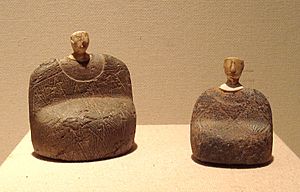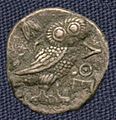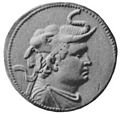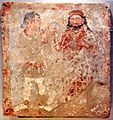Bactria facts for kids
Quick facts for kids Bactria
Balkh
|
|
|---|---|
| Province of the Achaemenid Empire, Seleucid Empire, Greco-Bactrian Kingdom and Indo-Greek Kingdom | |
| 2500/2000 BC–900/1000 AD | |
 Ancient cities of Bactria |
|
| Capital | Bactra |
| Historical era | Antiquity |
|
• Established
|
2500/2000 BC |
|
• Disestablished
|
900/1000 AD |
Bactria, also known as Bactriana, was an important ancient region in Central Asia. It was located in what is now parts of Afghanistan, Uzbekistan, and Tajikistan.
The ancient text called the Avesta described Bactria as "beautiful Bactria, crowned with flags." It was seen as one of the special lands created by the supreme deity Ahura Mazda.
Contents
History of Ancient Bactria
Bactria has a very long history, going back thousands of years. Many different groups of people lived there and ruled the region.
Early Civilizations in Bactria
Around 2200 to 1700 BC, a major Bronze Age culture existed in Bactria. This is known as the Bactria–Margiana Archaeological Complex (BMAC). It is also called the "Oxus civilization."
This ancient culture was centered around the upper Amu Darya (Oxus River). Archaeologists discovered its sites in the 1970s.
Bactria was also the capital of the legendary Kayanian kings of Iran. It is even mentioned in the famous Behistun Inscription by Darius the Great.
Bactria and Alexander the Great
In the 4th century BC, Bactria became a center of resistance. This was against the Macedonian invaders led by Alexander the Great.
After a struggle, Bactria eventually fell to Alexander. When Alexander died, his general Seleucus I took control of the region.
Independent Kingdoms and Empires
Later, Bactria gained its independence from the Seleucid Empire. This led to the creation of the Greco-Bactrian Kingdom. After that, the Indo-Greek Kingdom was formed.
By the 2nd century BC, the Parthian Empire conquered Bactria. In the early 1st century, the Yuezhi people formed the powerful Kushan Empire in Bactrian lands.
The Sasanian Empire of Iran also controlled parts of Bactria in the 3rd century. They lost it in the 4th century but got it back in the 6th century.
Islam and the Iranian Renaissance
In the 7th century, the Muslims conquered Iran. This marked the beginning of Islamization in Bactria.
Bactria played a key role in an Iranian cultural rebirth in the 8th and 9th centuries. The New Persian language, as a literary language, first appeared here. The Samanid Empire, founded by a Persian from Bactria, helped spread the Persian language. This led to the decline of the local Bactrian language.
People of Bactria
The people who lived in Bactria were called Bactrians. This region was important because many trade routes passed through it. These included routes from India and China, like the famous Silk Road.
Wealth and Trade
As early as the Bronze Age, these trade routes helped the people of Bactria become very wealthy. Much of the population was nomadic, meaning they moved from place to place.
The first cities in the area appeared around 2000 BC. The control of these valuable trade routes made Bactria attractive to foreign powers.
Foreign Rule and Influence
In the 6th century BC, the Persians conquered the Bactrians. Then, in the 4th century BC, Alexander the Great took control. These conquests ended Bactrian independence.
From about 304 BC, Bactria was part of the Seleucid Empire. Around 250 BC, it became the center of a Greco-Bactrian Kingdom. This kingdom was ruled by descendants of the Greeks who had settled there after Alexander's conquest.
The Greco-Bactrians worked with the local Bactrian leaders. By the early 2nd century BC, they had built a large empire. It stretched south into northwest India.
However, around 135 BC, invading Yuezhi tribes overran this kingdom. This invasion later led to the rise of the powerful Kushan Empire.
Language and Religion
The Bactrians spoke Bactrian. This was an Eastern Iranian language. It was related to ancient Avestan and modern Yaghnobi and Ossetian.
Before the rise of Islam, the main religions in Bactria were Zoroastrianism and Buddhism.
Today, the Bactrian people are mainly the ancestors of modern-day Tajiks.
Related pages
Images for kids
-
A Bactrian soldier from the tomb of Xerxes I, around 470 BCE.
-
A gold coin (stater) of the Greco-Bactrian Kingdom king Eucratides I.
-
Map showing the Greco-Bactrian Kingdom at its largest size, around 180 BCE.
-
Demetrius I of Bactria (205–171 BCE), who founded the Indo-Greek Kingdom. He wears an elephant scalp, showing his conquest of the Indus valley.
-
Zhang Qian leaving Emperor Han Wudi for his journey to Central Asia (138 to 126 BCE), from a Mogao Caves mural.
-
A worshipper from the Kushan Empire with figures representing Zeus, Serapis, and Ohrmazd, Bactria, 3rd century CE.
-
A painted clay and alabaster head of a Zoroastrian priest. He wears a special Bactrian-style headdress. Found in Takhti-Sangin, Tajikistan, from the Greco-Bactrian Kingdom, 3rd-2nd century BC.
See also
 In Spanish: Bactriana para niños
In Spanish: Bactriana para niños














